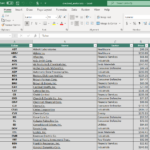Dividend Aristocrats In Focus: Nordson Corporation

Updated on March 8th, 2025 by Felix Martinez
Each year, we individually review each of the Dividend Aristocrats, a group of 69 stocks in the S&P 500 Index that have raised their dividends for at least 25 consecutive years.
To make it on the list of Dividend Aristocrats, a company must possess a profitable business model, a valuable brand, global competitive advantages, and the ability to withstand recessions. This is why Dividend Aristocrats can continue to raise their dividends in difficult years.
With this in mind, we have created a list of all 69 Dividend Aristocrats.
You can download your free copy of the Dividend Aristocrats list, along with important financial metrics such as price-to-earnings ratios and dividend yields, by clicking on the link below:
Disclaimer: Sure Dividend is not affiliated with S&P Global in any way. S&P Global owns and maintains The Dividend Aristocrats Index. The information in this article and downloadable spreadsheet is based on Sure Dividend’s own review, summary, and analysis of the S&P 500 Dividend Aristocrats ETF (NOBL) and other sources, and is meant to help individual investors better understand this ETF and the index upon which it is based. None of the information in this article or spreadsheet is official data from S&P Global. Consult S&P Global for official information.
One of the three newest members to join this list is Nordson Corporation (NDSN). Nordson has an incredible dividend growth track record, with a remarkable 61 years of consecutive increases.
This article will discuss the company’s business overview, growth prospects, competitive advantages, and expected returns.
Business Overview
Nordson was founded in 1954 in Amherst, Ohio, by brothers Eric and Evan Nord, but the company’s roots go back to 1909 with the U.S. Automatic Company.
Today, the company has operations in over 35 countries and engineers, manufactures, and markets products used for dispensing adhesives, coatings, sealants, biomaterials, plastics, and other materials. These products have applications ranging from diapers and straws to cell phones and aerospace.


Source: Investor Presentation
On February 19th, 2025, Nordson reported first quarter results for January 31st, 2025. (Nordson’s fiscal year ends October 31st.) The company reported that sales declined 2.8% to $615 million, with net income of $95 million ($1.65 per share). Adjusted EPS fell 7% to $2.06, while backlog grew 15%, indicating strong future demand.
Industrial sales dropped 11% due to weaker demand, while medical sales rose 21%, driven by acquisitions. Advanced Technology Solutions declined 11%. EBITDA was $188 million (31% of sales), down 4%, though profitability remained solid despite lower sales.
For Q2, Nordson expects sales between $650 million and $690 million, with adjusted EPS of $2.30–$2.50. The company sees improving order trends and a growing backlog as signs of recovery. CEO Sundaram Nagarajan remains confident in long-term growth, citing strong portfolio resilience despite market uncertainties.
Growth Prospects
From 2014 through 2024, Nordson grew earnings-per-share by a solid 10% annually. In its investment thesis, Nordson lists factors such as best-in-class technology that boosts client production while cutting costs, a worldwide service model, a balanced income stream, and a successful track record.
A growing demand for disposable goods, productivity investments, mobile computing, an increase in the use of medical devices, and the production of lightweight/lean vehicles are all areas of growth for the company’s adhesive and coating sectors, and would add to the company’s top line.
Nordson will keep making acquisitions to gain access to unique precision technologies and strengthen its competitive advantage.
For example, in 2023 Nordson completed its acquisition of the ARAG Group. ARAG is a global market and innovation leader in developing, producing and supplying precision control systems and smart fluid components for agricultural spraying.


Source: Investor Presentation
Our projection for 2025 earnings, based on management’s guidance midpoint, is for $9.90 per share.
We also project 10% EPS growth over the next five years, driven by an increase in top line revenue, modest margin expansion, and the favorable effects of acquisitions.
Competitive Advantages & Recession Performance
Nordson’s competitive advantage lies in its proprietary precision technologies. The business offers specialized and essential components used in various manufacturing processes.
This has enabled Nordson to muster an enormous installed base of customers worldwide. Due to its extensive global presence, Nordson has diversified its revenue geographically and by industry and segment.
However, this does not imply that Nordson is immune to economic downturns. Earnings decreased by -32% for the year during the Great Financial Crisis before rapidly increasing. Given the company’s reliance on global expansion, another recession could reduce its projections for near-term growth.
Valuation & Expected Returns
Nordson’s current price-to-earnings ratio is 21.7 based on our 2025 forecasted earnings-per-share of $9.90. This valuation is lower than the company’s trailing decade average P/E ratio of about 23.0. Given its solid prospects, we believe that 24 times earnings is a reasonable fair value estimate for Nordson.
Given shares trade under our fair value estimate today, Nordson stock could experience a positive return of roughly 2.3% per year over the next five years from an expanding multiple.
Nordson also has a 1.5% dividend yield, which has increased yearly for 61 years. Furthermore, we forecast a payout ratio of only 32% for 2025, leaving ample room for continued increases in the years ahead.
Combining the company’s 1.5% dividend yield with the 10% forecasted EPS growth rate, and the potential valuation tailwind, we see Nordson stock generating total returns of 13.8% per year in the intermediate term. As a result, Nordson receives a buy rating at this time.
Final Thoughts
The company’s growth prospects seem promising, and Nordson has an impressive track record of earnings and dividends. The company is currently trading at a lower level, which increases its attractiveness.
The company may continue its incredible earnings-per-share growth this year or take a breather and remain flat. However, we believe Nordson will continue growing over the long term. This long-term earnings growth and the very conservative dividend payout ratio should see the company increasing its dividend for many more years ahead.
Additionally, the following Sure Dividend databases contain the most reliable dividend growers in our investment universe:
If you’re looking for stocks with unique dividend characteristics, consider the following Sure Dividend databases:
The major domestic stock market indices are another solid resource for finding investment ideas. Sure Dividend compiles the following stock market databases and updates them monthly:
Thanks for reading this article. Please send any feedback, corrections, or questions to [email protected].

















